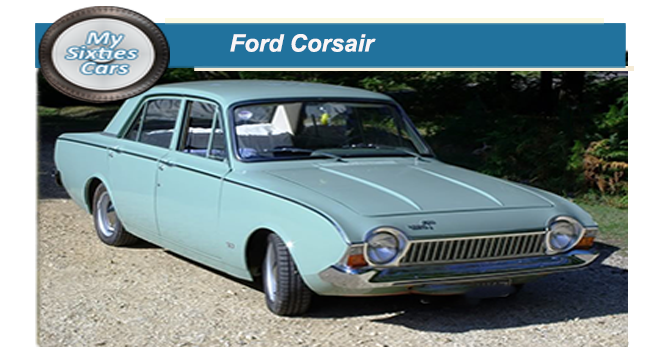
In the early Sixties, Ford UK was riding on an unprecedented wave of success, mostly thanks to their top-selling Cortina Mark I series.
N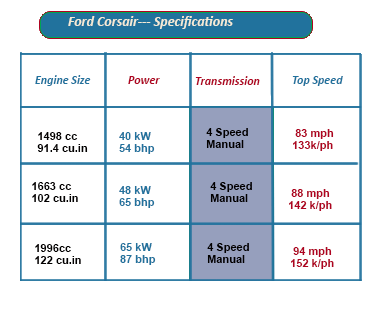 ot content to rest on their laurels in October 1963 Ford announced the launch of a slightly larger, rather less handsome five-seater saloon to provide yet another option in the medium price bracket between the small and large saloons that they named the Corsair.
ot content to rest on their laurels in October 1963 Ford announced the launch of a slightly larger, rather less handsome five-seater saloon to provide yet another option in the medium price bracket between the small and large saloons that they named the Corsair.
The Ford Corsair 102E, to give the car its full title, stood out thanks to its tapering nose line and otherwise, the angular shape was cast very much in the conventional Cortina mould.
P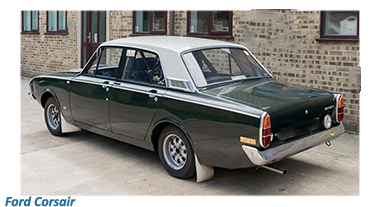 owered by a 1498-cc engine, the Ford Corsair was initially offered in two- and four-door form with bucket front seats and a central gear-change as standard.
owered by a 1498-cc engine, the Ford Corsair was initially offered in two- and four-door form with bucket front seats and a central gear-change as standard.
In January 1964 two- and four-door Corsairs were available in standard, deluxe, GT, floor- and column-change versions.
In September of 1965, Ford of Dagenham followed the lead of Ford Germany by introducing a V4 engine for use in the Corsair range marketed as the 120GT series.
![]()
Powered by a 1663-cc 3004E unit, the 120GT suffered from some teething problems brought about by an inherent imbalance of such a configuration.
Ford UK’s engineers rapidly tackled the problem, and a separate balance shaft had to be built to smooth this out.
I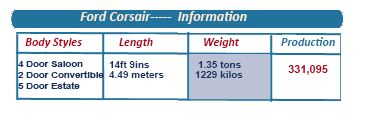 n the first cars, it was not altogether successful, the engine being lumpy and noisy at high speed, in contrast to the smoothness of the beautiful high-revving in-line engines.
n the first cars, it was not altogether successful, the engine being lumpy and noisy at high speed, in contrast to the smoothness of the beautiful high-revving in-line engines.
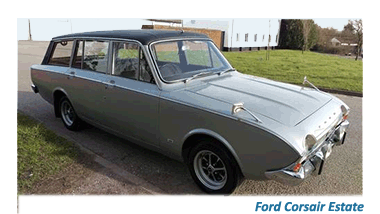 The engineers at Ford UK wasted little time in ironing these , teething troubles out.
The engineers at Ford UK wasted little time in ironing these , teething troubles out.
The new model continued with external `V4' badges to distinguish it, larger front discs, self-adjusting rear drums and Aeroflow ventilation as standard.
In March 1966 a four-door GT Estate with the new 2-litre engine appeared, in September the new Cortina gearbox and gear-change were fitted, using a smaller floor tunnel, and then, in November, the GT was discontinued in favour of the more refined middle-class 'prestige' car, the Corsair 2000.Also using the 1996-cc 3006E engine, the new model was announced in January 1967 in deluxe saloon and estate car versions, with servo-assisted brakes, wide-rimmed wheels and radial tires as standard.
![]()
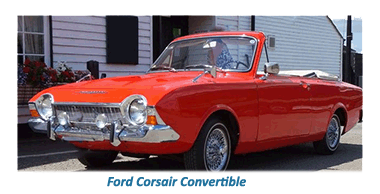 In May 1967 a wooden fascia was added to the Corsair 2000 along with chrome window surrounds which gave the model that necessary touch of class.
In May 1967 a wooden fascia was added to the Corsair 2000 along with chrome window surrounds which gave the model that necessary touch of class.
In September of the same year, airflow modifications common to the rest of the range were incorporated, while bucket-formed rear seats and a console clock were added to the 2000E.
Having enjoyed seven years of consistent sales, Ford decided that the time was phase out the Corsair in 1970, replacing it with the Mk 3 Cortina.
During its production run of just over 300,000 Corsairs were sold, although very few have survived – a sad but sure sign of the model's lack of collector appeal.






